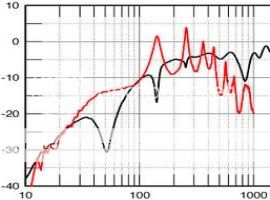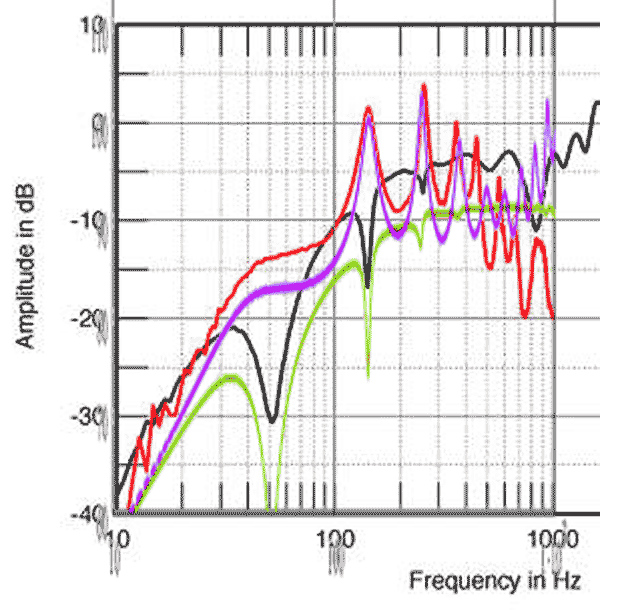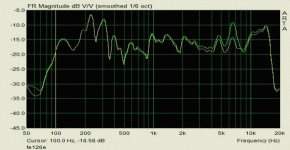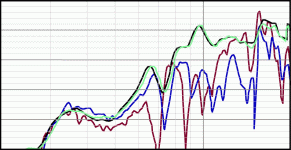Scottmoose said:Hey, Chris -is that where all the empty tins of acrylic paint used for EnABLE-ing drivers are going?
actually, I think it's modeling hobby paint, and is sold in small plastic or glass vials, so it would take hundreds of pairs to empty that many bottles.
all in due time
When i speak of pressure, its not lbs^2". I am just reffering to a pressure above ambient or when the cone movement is in a rest state on the sine curve. It dosent take 1mm cone movement to produce a low frequency, its the question of the SPL at a given frequency.
If you design in the cone loading correctly the X max will be reached at the same LF SPL as the balance of the SPL of the FR spectrum at a given efficency.
Now this will not give concert levels of sound with a 90 db driver, but will afford a balanced FR and an undistorted response at normal listening levels.
Give it a break guys, its a single driver. You can only squeeze a given amount out of a given set of physical parameters.
The one thing that has bothered me is the reported " cone moving in and out like crazy" in a forum/test/review for a commercial horn ( i believe we all know who). Yes it will get louder, the downfall is the signal distortion. Anytime you move the VC away from the maximum magnetic flux density there is less control over the movement in relation to the sine wave input.
Then its a factor of the field effect,Qms of the driver and loading.
All this has to be taken into account when designing a BLH.
ron
If you design in the cone loading correctly the X max will be reached at the same LF SPL as the balance of the SPL of the FR spectrum at a given efficency.
Now this will not give concert levels of sound with a 90 db driver, but will afford a balanced FR and an undistorted response at normal listening levels.
Give it a break guys, its a single driver. You can only squeeze a given amount out of a given set of physical parameters.
The one thing that has bothered me is the reported " cone moving in and out like crazy" in a forum/test/review for a commercial horn ( i believe we all know who). Yes it will get louder, the downfall is the signal distortion. Anytime you move the VC away from the maximum magnetic flux density there is less control over the movement in relation to the sine wave input.
Then its a factor of the field effect,Qms of the driver and loading.
All this has to be taken into account when designing a BLH.
ron
Guys:
Again, many thanks for all of your comments. I now feel more confident, "knowing what to expect" from the various procedures in tuning these horns. I forward to adding the SupraBaffles, and it looks like I will make a pair of reflectors too. I was unaware the reflectors provided benefits beyond a mere bass extension. Learning...it is why this forum is so great!
Regarding Xmax, I can only add one comment. I'm listening from 2 M away, and by driving the Frugals with just a 2.5 W/p/c 2A3...I can get a headache from the high volume! I do not perceive the system sounding "pushed" or starting to break up...neither the amp nor the speakers. Sounds rather clean and relaxed to me. Anyway, I never listen to it at ear-ringing volumes anyway, even though it will do it if needed.
Even if Xmax is truly being exceeded...it still sounds sweet to me!
-Dennis
Again, many thanks for all of your comments. I now feel more confident, "knowing what to expect" from the various procedures in tuning these horns. I forward to adding the SupraBaffles, and it looks like I will make a pair of reflectors too. I was unaware the reflectors provided benefits beyond a mere bass extension. Learning...it is why this forum is so great!
Regarding Xmax, I can only add one comment. I'm listening from 2 M away, and by driving the Frugals with just a 2.5 W/p/c 2A3...I can get a headache from the high volume! I do not perceive the system sounding "pushed" or starting to break up...neither the amp nor the speakers. Sounds rather clean and relaxed to me. Anyway, I never listen to it at ear-ringing volumes anyway, even though it will do it if needed.
Even if Xmax is truly being exceeded...it still sounds sweet to me!
-Dennis
Also, AFAIK, the only software that can model the wavefront pressure, expansion & thermal issues, and the effect of the curved mouth is Ron Clarke's.
I have nerver released my programming, and probably never will, and there is a simple reason. Its not like Martins where you plug in numbers and get an instant result. Its more of a simulation of whats occuring and i stop the actions at different points and measure the actual. A lot of ppl would have trouble understanding the measurement points and the actual response. All this is going on at different frequencies which overlap and cause changes in the actual pressure points at different points in space and time.
Think a 50 channel O scope in x/y/z at different times, and in contionus movement. I have been working with wave response for over 40 years and its still difficult for me.
Also there is a great deal of propertiary programming involved as well as some issues of legal involvement as i took a great deal of my past studies from military work i had accomplished.
ron
I have nerver released my programming, and probably never will, and there is a simple reason. Its not like Martins where you plug in numbers and get an instant result. Its more of a simulation of whats occuring and i stop the actions at different points and measure the actual. A lot of ppl would have trouble understanding the measurement points and the actual response. All this is going on at different frequencies which overlap and cause changes in the actual pressure points at different points in space and time.
Think a 50 channel O scope in x/y/z at different times, and in contionus movement. I have been working with wave response for over 40 years and its still difficult for me.
Also there is a great deal of propertiary programming involved as well as some issues of legal involvement as i took a great deal of my past studies from military work i had accomplished.
ron
Svein_B said:The Frugal horn does not hae much real bass response below 100 Hz.
Here is the Stereophile measurement of an equivalent product (driver and port):
Atkinson measured Ed's horn out from any boundaries, so the measured response is really only of academic interest (Ed freaked over this)
The Ed Horn has a 13 cm width, the FH 14 cm so a level 0 FH has about an 8% larger mouth. With Ron'd curved rear the mouth gets a bit larger yet, but the big gain is a much better release of the waveform from the mouth. The deflector comes close to doubling the effective mouth size, and eliminates most of the reflections that otherwise get reflected back up the horn (assumming proper positioning in a corner.
These were designed for a corner as a further part of the horn. Next best is placed across the corner of the room firing more or less at the listener and pushed right back against the wall at an angle.
dave
Re: More Questions on Frugal Horn Tuning
The MJK software is not yet able to simulate corner positioning. Martin has a set of FHs and he is using them as an aide in adding this capability to his SW.
dave
Originally posted by Diogenio [/i
4) Scott...if you are willing to please do another simulaton, I'd sure like to see the frequency response of the Frugal Horn/FE126e combo...with and without SupraBaffle, and with and without reflector if that is possible to model in your program.
The MJK software is not yet able to simulate corner positioning. Martin has a set of FHs and he is using them as an aide in adding this capability to his SW.
dave
Hello Diogenio,
press chamber 2.3 L
the stroke changes minimum, but the frequence
now looks more or less exactly like the red line
of the measurement of Stereophile,
In a corner the SPL rises but the cone movement is the same.
The frugal horn is after 2m no horn , it is a waveguide,
the step of the funnel constante is to large.
so if you can listen only 85 dB max. and you need a sub below
100 Hz, than the enclosure is much to large, this you can get smaller.
Also not mentioned here the distance between the mouth
and the driver, here ~0,4-0,5 m.
Scottmoose, I am happy that you didn´t compair it to the
80 cm bass of fostex, there is only 0,1 mm stroke at 1 Watt.
Be happy that I called it kiding, i can take another word,
and think about : I speak german and only school english
from 35 years ago, so the understanding is not 100% or
and it takes time.
BTW: AJ horn can simulate more or less all enclosure types
and has the best reputation also by speaker producers.
press chamber 2.3 L
the stroke changes minimum, but the frequence
now looks more or less exactly like the red line
of the measurement of Stereophile,
In a corner the SPL rises but the cone movement is the same.
The frugal horn is after 2m no horn , it is a waveguide,
the step of the funnel constante is to large.
so if you can listen only 85 dB max. and you need a sub below
100 Hz, than the enclosure is much to large, this you can get smaller.
Also not mentioned here the distance between the mouth
and the driver, here ~0,4-0,5 m.
Scottmoose, I am happy that you didn´t compair it to the
80 cm bass of fostex, there is only 0,1 mm stroke at 1 Watt.
Be happy that I called it kiding, i can take another word,
and think about : I speak german and only school english
from 35 years ago, so the understanding is not 100% or
and it takes time.
BTW: AJ horn can simulate more or less all enclosure types
and has the best reputation also by speaker producers.
planet10 said:
Atkinson measured Ed's horn out from any boundaries, so the measured response is really only of academic interest (Ed freaked over this)
. . .
dave
OK, so let us have a look at Ed's own measurements: http://www.audiocircle.com/circles/index.php?topic=44701.0
Attached is also a sample of my measurement, in a small room with no proper corners.
SveinB.
Attachments
Svein_B said:OK, so let us have a look at Ed's own measurements: http://www.audiocircle.com/circles/index.php?topic=44701.0
Attached is also a sample of my measurement, in a small room with no proper corners. SveinB.
I rest my case.
Horst -your English is fine. I had German beaten into me fifteen years ago, but it's leaked out.
"Be happy that I called it kiding, i can take another word"
I beg your pardon?
I found MJK's software to be more useful for the DIYer for a couple reasons:
It allows the builder to treat the horn build in sections that have linear increase in the CSA. This seems to be more realistic since I would never attempt a true hyper/expo horn.
It understands the Hybrid TL/Horn mechanics and models them very well.
It allows adding damping material; a necessary evil in a compromised horn
I used AJ horn as a second opinion and quite honestly after looking at the actual measurements in my listening area, they seem to be more similiar to MJK's output.
It allows the builder to treat the horn build in sections that have linear increase in the CSA. This seems to be more realistic since I would never attempt a true hyper/expo horn.
It understands the Hybrid TL/Horn mechanics and models them very well.
It allows adding damping material; a necessary evil in a compromised horn
I used AJ horn as a second opinion and quite honestly after looking at the actual measurements in my listening area, they seem to be more similiar to MJK's output.
You & me both. I'm not a fan of AJ Horn at all. It's better than some, but like any piece of software, it has limitations, and it's ability to accurately simulate particularly QW action is sporadic. I tried a copy out of interest a while back, and eventually junked it. It's just not flexible enough.
The idea of trying to use Ron's software to plot simultaneous wavefronts over a range of frequencies at different points in an enclosure, then adjusting the dimensions to reshape / optimise them, gives me nightmares, even if it could be released (no chance of that). If Ron still finds it hard, with 4 decades of experience, then methinks the rest of us wouldn't have any chance at all.
The idea of trying to use Ron's software to plot simultaneous wavefronts over a range of frequencies at different points in an enclosure, then adjusting the dimensions to reshape / optimise them, gives me nightmares, even if it could be released (no chance of that). If Ron still finds it hard, with 4 decades of experience, then methinks the rest of us wouldn't have any chance at all.
Here is a comp i did of Ed's measures that gets the scales the same. Ed was quite specific in saying, listening to the speakers not the the measurements. Sill if one ignores the ceiling height suckout, useful response to 65 Hz or so....out of the corner, no better than an mFonken (but with better dynamics i expect)
What is really useful here is the comparison of corner/no corner.
The curved mouth/deflector gives the FH an edge on the Ed Horn (BTW Ron did a deflector for the EdHorn too, but it was poo-pooed by Ed and has mostly been ignored), Ron's estimate being something like 10-20 Hz. Listening in Chris's room with speakers properly in the corners suggests usable bass to 50-70 Hz.
It will be very interesting to see what Martin comes up with when he measures the FH. These measures (& the extra capability of Martin's models) were always intended to help develop a better, 2.0 version of the Frugel-Horn -- that does not negate how enjoyable the current FH is to listen too)
Which reminds me, Ron are you still intereted in a pair for your GF's place? I am just about ready to box yours up and send them along if you are. Contact me direct please.
dave
What is really useful here is the comparison of corner/no corner.
The curved mouth/deflector gives the FH an edge on the Ed Horn (BTW Ron did a deflector for the EdHorn too, but it was poo-pooed by Ed and has mostly been ignored), Ron's estimate being something like 10-20 Hz. Listening in Chris's room with speakers properly in the corners suggests usable bass to 50-70 Hz.
It will be very interesting to see what Martin comes up with when he measures the FH. These measures (& the extra capability of Martin's models) were always intended to help develop a better, 2.0 version of the Frugel-Horn -- that does not negate how enjoyable the current FH is to listen too)
Which reminds me, Ron are you still intereted in a pair for your GF's place? I am just about ready to box yours up and send them along if you are. Contact me direct please.
dave
Attachments
Svein_B said:The Frugal horn does not hae much real bass response below 100 Hz.
Here is the Stereophile measurement of an equivalent product (driver and port):

SveinB
Hi, sorry for my late reply to this, but can you reference a source for those measurements.
When you say "equivalent product" does that mean that those measurements are from a HornShope horn?
Cheers,
Gio
gmilitano said:sorry for my late reply to this, but can you reference a source for those measurements.
The source is the Stereophile website, from the John Atkinson measures that accompanied Art Dudley's review (that garnered the Hornshoppe Horn a Class C rating)
Here are those same JA measures overlaid with a sim Martin did of the 1st experiment that lead to the Frugel-Horn (the modified Buschhorn on the last page of the FH plans). All the ripples in the same place strongly suggest that the modded B-Horn is substantially the same (in the bass) as the Hornshoppe Horn. Until someone takes a chainsaw to a set of Ed's Horn we'll never know the detail. It is moot anyway -- at least to me -- the FH sounds better than the modded B-Horn (no comparisons yet with an actual Ed Horn).
The 1st alpha build that lead from that was a better sounding box than the modded B-Horn, but should have similar bass extension (8% more mouth and not quite as severe an aspect should give it a bit of an advantage). This would be equivalent to the Level 0 build of a Frugel-Horn.

[When you say "equivalent product" does that mean that those measurements are from a HornShope horn?
Yes... roughly equivalent but only to the Level 0, the Level 1, 2, & 3 enhancements that Ron came up with are significant.
dave
planet10 said:Here is a comp i did of Ed's measures that gets the scales the same. Ed was quite specific in saying, listening to the speakers not the the measurements. Sill if one ignores the ceiling height suckout, useful response to 65 Hz or so....out of the corner, no better than an mFonken (but with better dynamics i expect)
It will be very interesting to see what Martin comes up with when he measures the FH. These measures (& the extra capability of Martin's models) were always intended to help develop a better, 2.0 version of the Frugel-Horn -- that does not negate how enjoyable the current FH is to listen too)
Hi Dave, could you add a legend to that plot.
I seem to remember reading that the hornshoppe horn would get close to about -3dB at 50Hz in a corner. That does not seem to be the case in the measurements.
I just got a mailer from quarter-wave.com saying that he will have the project up shortly. I am looking forward to the results. I imagine he will be using a FE126E. What will be interesting is comparisons of actual measurements to his software.
- Status
- This old topic is closed. If you want to reopen this topic, contact a moderator using the "Report Post" button.
- Home
- Loudspeakers
- Full Range
- New Frugel Horns: Tuning Problems

